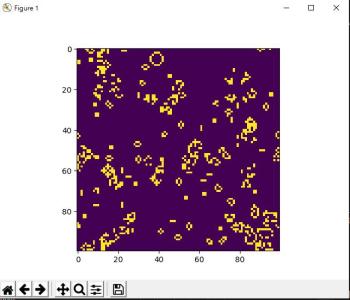
最近有看到這影片,覺得很有趣
生命遊戲:另一種計算機 |混亂博物館
規則:
If a cell is ON and has fewer than two neighbors that are ON, it turns OFF
(生命害怕孤獨: 鄰居少於2個則死亡)
If a cell is ON and has either two or three neighbors that are ON, it remains ON.
(生命持續: 鄰居為2-3個生命. 保持原樣)
If a cell is ON and has more than three neighbors that are ON, it turns OFF.
(生命討厭擁擠: 鄰居多於3個.則死亡)
If a cell is OFF and has exactly three neighbors that are ON, it turns ON.
(生命繁殖: 目前死亡.鄰居有3個生命則有生命)
然後找看看,發現有程式碼可以玩看看:
Conway’s Game Of Life (Python Implementation)
# Python code to implement Conway's Game Of Life
import argparse
import numpy as np
import matplotlib.pyplot as plt
import matplotlib.animation as animation
# setting up the values for the grid
ON = 255
OFF = 0
vals = [ON, OFF]
def randomGrid(N):
"""returns a grid of NxN random values"""
return np.random.choice(vals, N*N, p=[0.2, 0.8]).reshape(N, N)
def addGlider(i, j, grid):
"""adds a glider with top left cell at (i, j)"""
glider = np.array([[0, 0, 255],
[255, 0, 255],
[0, 255, 255]])
grid[i:i+3, j:j+3] = glider
def addGosperGliderGun(i, j, grid):
"""adds a Gosper Glider Gun with top left
cell at (i, j)"""
gun = np.zeros(11*38).reshape(11, 38)
gun[5][1] = gun[5][2] = 255
gun[6][1] = gun[6][2] = 255
gun[3][13] = gun[3][14] = 255
gun[4][12] = gun[4][16] = 255
gun[5][11] = gun[5][17] = 255
gun[6][11] = gun[6][15] = gun[6][17] = gun[6][18] = 255
gun[7][11] = gun[7][17] = 255
gun[8][12] = gun[8][16] = 255
gun[9][13] = gun[9][14] = 255
gun[1][25] = 255
gun[2][23] = gun[2][25] = 255
gun[3][21] = gun[3][22] = 255
gun[4][21] = gun[4][22] = 255
gun[5][21] = gun[5][22] = 255
gun[6][23] = gun[6][25] = 255
gun[7][25] = 255
gun[3][35] = gun[3][36] = 255
gun[4][35] = gun[4][36] = 255
grid[i:i+11, j:j+38] = gun
def update(frameNum, img, grid, N):
# copy grid since we require 8 neighbors
# for calculation and we go line by line
newGrid = grid.copy()
for i in range(N):
for j in range(N):
# compute 8-neghbor sum
# using toroidal boundary conditions - x and y wrap around
# so that the simulaton takes place on a toroidal surface.
total = int((grid[i, (j-1)%N] + grid[i, (j+1)%N] +
grid[(i-1)%N, j] + grid[(i+1)%N, j] +
grid[(i-1)%N, (j-1)%N] + grid[(i-1)%N, (j+1)%N] +
grid[(i+1)%N, (j-1)%N] + grid[(i+1)%N, (j+1)%N])/255)
# apply Conway's rules
if grid[i, j] == ON:
if (total < 2) or (total > 3):
newGrid[i, j] = OFF
else:
if total == 3:
newGrid[i, j] = ON
# update data
img.set_data(newGrid)
grid[:] = newGrid[:]
return img,
# main() function
def main():
# Command line args are in sys.argv[1], sys.argv[2] ..
# sys.argv[0] is the script name itself and can be ignored
# parse arguments
parser = argparse.ArgumentParser(description="Runs Conway's Game of Life simulation.")
# add arguments
parser.add_argument('--grid-size', dest='N', required=False)
parser.add_argument('--mov-file', dest='movfile', required=False)
parser.add_argument('--interval', dest='interval', required=False)
parser.add_argument('--glider', action='store_true', required=False)
parser.add_argument('--gosper', action='store_true', required=False)
args = parser.parse_args()
# set grid size
N = 100
if args.N and int(args.N) > 8:
N = int(args.N)
# set animation update interval
updateInterval = 50
if args.interval:
updateInterval = int(args.interval)
# declare grid
grid = np.array([])
# check if "glider" demo flag is specified
if args.glider:
grid = np.zeros(N*N).reshape(N, N)
addGlider(1, 1, grid)
elif args.gosper:
grid = np.zeros(N*N).reshape(N, N)
addGosperGliderGun(10, 10, grid)
else: # populate grid with random on/off -
# more off than on
grid = randomGrid(N)
# set up animation
fig, ax = plt.subplots()
img = ax.imshow(grid, interpolation='nearest')
ani = animation.FuncAnimation(fig, update, fargs=(img, grid, N, ),
frames = 10,
interval=updateInterval,
save_count=50)
# # of frames?
# set output file
if args.movfile:
ani.save(args.movfile, fps=30, extra_args=['-vcodec', 'libx264'])
plt.show()
# call main
if __name__ == '__main__':
main()
實際運作
相當特別~
當然實際生命的運行遠比這個複雜多了


留言板
歡迎留下建議與分享!希望一起交流!感恩!